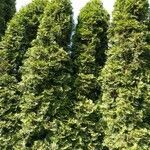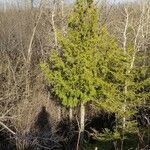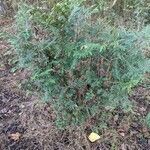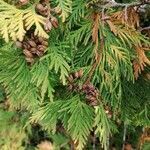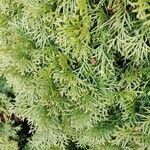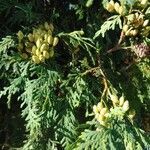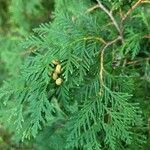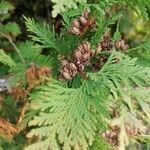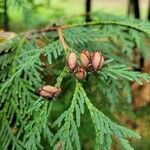Trees to 15(-38) m tall; trunk 0.9(-1.8) m d.b.h.; bark reddish brown or grayish brown, fibrous, fissured; crown conical. Leaves on both sides of branchlets dull yellowish-green; facial leaves (1.5-)3-5 mm, abaxial gland conspicuous, apex acute; lateral leaves slightly shorter than or as long as facial leaves, apex incurved. Pollen cones reddish, 1-2 mm. Seed cones brown, ellipsoid, (0.6-)0.9-1.4 cm; fertile cone scales ca. 4. Seeds reddish-brown, 4-7 mm including wings.
An evergreen tree. It is a narrow cone shape and grows 20 m high. It spreads 4.5 m wide. The bark is orange-brown and peels off in strips. The leaves are scale like and very small. They are glossy yellow above and white underneath. The male and female flowers occur on the same tree. The male flowers are red and the female flowers are yellow-brown. They occur in separate clusters at the ends of shoots. The fruit are oblong and 1 cm long. They are upright cones.
Conical tree to 20 m, with widely spreading branches; ultimate branchlets very soft and flat, 1–2 mm wide; lvs closely imbricate, broadly ovate to rotund, 2–4 mm, glandular, persisting and enlarging on the older branches; cone ca 1 cm, the outer scales nearly as long as the inner; 2n=22. Moist or wet soil, often in swamps; Que. and N.S. to Hudson Bay, s. to N.J., O., n. Ind. and Ill., Wis., Minn., and in the mts. to N.C. and Tenn.
